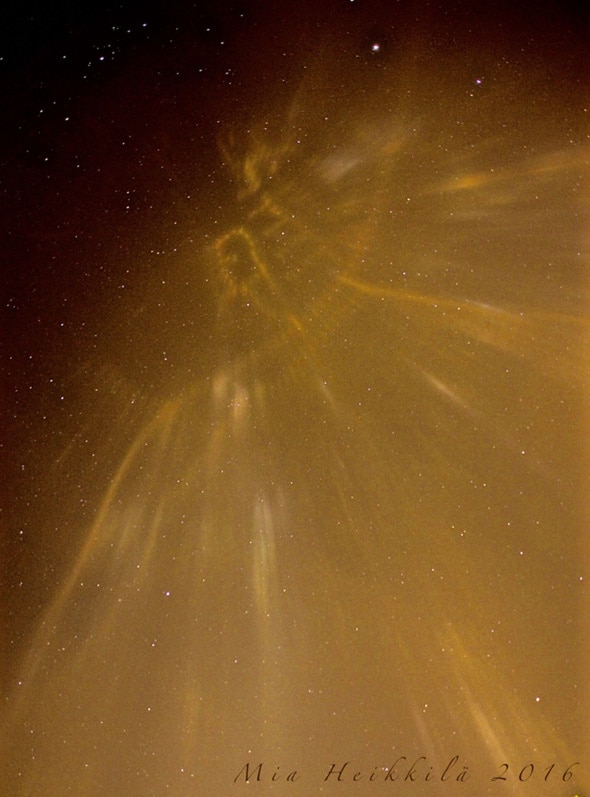Create a free profile to get unlimited access to exclusive videos, sweepstakes, and more!
One of the Single Weirdest “Lights in the Sky” Events Ever: City Map
Drawn in the Sky

Look at that picture!
Seriously, this is one of the single most amazing optical phenomena I have ever seen, and I’ve seen a lot of weird stuff. It was taken on Jan. 13, 2016, by Mia Heikkilä in Eura, Finland, and I’ll admit it took me a moment to figure out what it was. When I did, literally, my jaw dropped.
So. What the heck is that thing?
It’s a light pillar. Or, more accurately, a lot of light pillars, and it’s probably the most striking example of them ever. This is terribly cool, so bear with me here a sec.
Light pillars are an optical phenomenon caused by ice crystals suspended in the air. These crystals can take on a variety of shapes as water freezes, but a common one is a flat, hexagonal crystal. They’re heavier than air, so they fall, but if they’re the right size (bigger than about 20 microns across, 1/5th the width of a typical human hair), they fall slowly and stay oriented flat, parallel to the ground. As one website put it, think of it like a flying saucer landing.
Light hitting the flat sides or bottom of the crystal gets reflected. If the angle between the source, the crystal, and the observer (you) is just right, you’ll see that light reflected right at you. Here’s a diagram I drew to illustrate this:
The light reflecting off the crystals leaves at the same angle it hits, so only certain crystals will be at the right distance and height to reflect the light directly toward you. This creates, from your viewpoint, a vertical ray of light directly above the position of the source. If the crystal isn’t in the right position (say to your left or right), you don’t see the reflected light because the angles are wrong.
This is what causes a Sun pillar, a vertical column of light directly above the setting Sun. I saw one of these once … I think; I’ve never been able to confirm it, though I do think that’s what was going on.
Pillars can also form over any bright, compact source of light. Streetlights, houses, anything like that can also create these pillars. I wrote about a photo of this taken by Francis Anderson during a lunar eclipse that was quite pretty. It was that photo (and one posted on APOD a few years back) that gave me what I needed to understand the remarkable photo at the top of this article.
What you are seeing are light pillars caused by lights in the city of Eura, Finland. Streetlights, buildings, what have you; each cast their luminance upwards, where they hit widespread hexagonal ice crystals in the air, and the light was reflected back toward Heikkilä. This created a light pillar for each source, separated because of their physical separation on the ground. Due to perspective, ones that were closer to Heikkilä made smaller dots in the sky, while ones farther away made columns.
The result? A map of the city projected vertically into the sky! And it’s reversed due to the crystals reflecting the light, together with Heikkilä’s viewing angle. You can actually trace the streets in the sky using the lights as a reference. Incredible.
I’m still a bit slack-jawed thinking about this. The reversed map is amazing enough, but the perspective effect adds a depth to it that’s truly other-worldly (it’s the same sort of effect that causes what’s called a corona in an aurora as well).
Can you imagine? What it must have been like to walk outside and see this fantastically detailed and highly structured phenomenon etched across the sky?
I’ve seen fireballs blazing through the heavens, rockets re-entering, all manners of transits and eclipses and rare phenomenon, because I spend a lot of time outside looking up. But I have never, ever seen anything like this. It’s so rare I suspect I never will … so I’m glad Heikkilä was there to get these photographs.
The sky is full of wonder and surprise. Don’t forget to look up at it every now and again.
Tip o’ the lens cap to Timo Jousimo and Pasi Jokela.


























